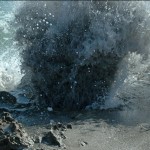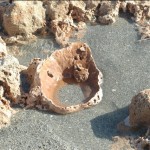What I learned in school today:
Sugar sand is very fine-grained sand that occurs at various sites around south Florida. There’s actually a city park near where I live called Sugar Sand Park. Sugar sand is a very fine grained sand. Here in south Florida most sand on the beach has a very high shell content; as you move farther and farther up the dune system, the sand gets finer and finer, though. This is because the dunes are formed by the constant onshore breeze blowing fine sand particles inland. The finest sand travels the farthest, and settles on the highest areas. Whatever shell content there was is either sorted out by the wind and left behind, or it actually percolates out as rains fall on the sand and dissolve the calcium carbonate, leaving only the finer quartz particles behind.
At the Nature Conservancy’s Blowing Rocks Preserve in Jupiter, we saw some outcroppings of Anastasia limestone that have actually become laminated crust. This happens when the coquina dissolves over time, and then reprecipitates; the technical term for this type of rock is caliche crust. The preserve gets its name from the blowholes:

These features are formed by the combined action of scouring by wave-driven sand (so not only do you get wave erosion, you get sandblasting as well!) and pitting and wind erosion from above, as the seawater that sloshes over the top of the rock boils in the sun (well, it doesn’t really boil…) and gets slightly acidic. As you can imagine, the action of wave, tide, and sandblasting is slightly quicker than erosion from above, so the rocks here are steeply undercut, forming caves and ledges in addition to blowholes. (You don’t even need to look closely at the image above to see how much sand is contained in this water being forced up through the blowhole.)
And here you can see the process of coquina lamination and pitting. This coquina cup has laminated crust edges, and the bowl of the cup contains seawater sloshover that is in the process of acidifying and slowly eroding through the underlying substrate. Eventually, as the rocks seaward of this one crumble into the ocean, a blowhole will probably form here as well:

While we were at the preserve, we ran into some Boy Scout troops participating in the beach cleanup. It’s sort of a pointless gesture, cleaning up a high-energy beach. All the trash that’s on the beach gets cleaned up by city and county work crews. If you want to really make an impact, go clean up the trash in the Intracoastal. The beach is a high-energy system; anything that washes up onshore is not going to wind up back out in the ocean. The combined action of wind and wave will make sure that it stays onshore. In the Intracoastal, on the other hand, all the trash just sloshes around with the tide, going up and down and around, but never getting high and dry. Spend a few minutes cleaning a tidy beach, and I’ll smile politely. Spend a few hours picking plastic bags out of a mangrove swamp and I’ll tell you you’ve done some good work. Heck, I might even buy you a beer. (Does Budweiser count as an import now that Anheuser-Busch has been bought by a Belgian-Brazilian consortium?)
After Blowing Rocks, we went to the Loggerhead Marine Life Center in Juno Beach. I hadn’t been there in years, since it was a trailer with a few tanks outside. Now the place has a large exhibit room, a nice gift shop, turtle tanks, and a state-of-the-art hospital with a digital x-ray machine and everything. There we heard all about sea turtles.
And then, as we have for the previous two weeks, it was time to head back to Mounts Botanical Library for a series of powerpoints and a video featuring Marty Main, biologist for UF/IFAS, the sponsors of the Florida Master Naturalist Program. I’ll spare you the details, if you don’t mind.
